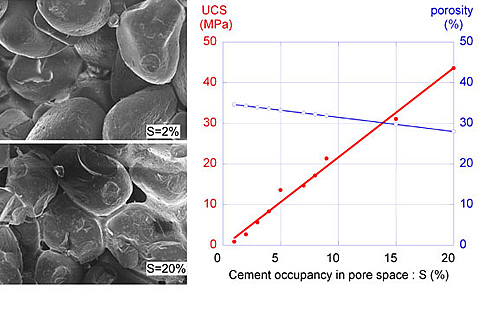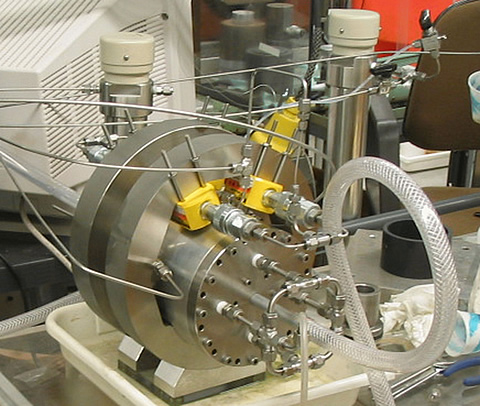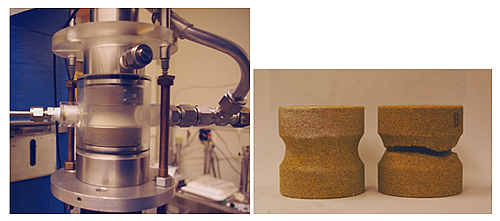Instability of wellbores is an industry-wide problem with a global annual cost of $2 billion. Particularly in weakly cemented and uncemented sands, the low strength of the rock can cause severe sanding and breakout problems in oil and gas production wells that can cost as much as $40 million per well for wells in deep water. In contrast, sand production is sometimes desirable for faster recovery of low-mobility hydrocarbons, as in some types of cold heavy oil production.
However, in neither case have predictive relationships based on rock properties and the borehole environment been well-established. Further, there are increasing numbers of cases that show development of sand-producing, fracture-like failure features within weakly cemented sand formations that resemble "piping" failure of cohesionless sand. This type of failure can be particularly important in gas wells that experience large flow rates that assist the hydrodynamic erosion of weakly cemented sand.
Project Results
LBNL developed a series of new laboratory techniques, including 1) a new fabrication technique for synthetic sandstone samples with a wide range of porosity and strength, 2) a low-frequency (sonic cross-hole to logging frequency) acoustic property measurement device, 3) a modified uniaxial compression testing method for studying breakout of an anisotropically loaded borehole with fluid flow, and 4) a portable X-ray transparent true-triaxial loading cell for a borehole breakout/sanding experiment. Using the synthetic sandstone samples a series of laboratory experiments were conducted to examine the initiation and propagation of sand production.
Benefits
A Quantitative understanding of the sanding mechanism will have a significant impact on controlling sand production and enhancing oil and gas recovery. Through a series of laboratory experiments, this project seeks to quantify the relationships between weakly cemented sand stability and hydrocarbon induced borehole sanding. The effects of in-situ stress and hydrodynamic forces exerted by borehole fluid production will also be investigated.
The relationships obtained, calibrated by field data provided by industry participants, will provide a guideline for predicting borehole stability and sanding. These predictions can be used to either avoid unwanted excess production of sand and borehole failure or exploit the situation for enhanced oil and gas recovery.
Project Summary
This project will involve a series of laboratory experiments to understand the relationships between grain-scale properties of weakly cemented sand including porosity, intergranular cohesion, and grain geometry. Core-scale mechanical and acoustic properties will be developed to predict the behavior of a drilled borehole.
A major breakthrough of the project is the development of a new laboratory technique to fabricate synthetic sandstone samples with a wide range of material properties (porosity from 7% up to 42%). These samples are fabricated from quartz sand and soda-lime glass micropowder, and then heated above the melting temperature of the glass to cement the sand grains together. The primary reasons for using synthetic material are that (1) natural weakly cemented sand cores are difficult to obtain, (2) uniform and repeatable material properties are obtainable, and (3) the grain-scale parameters, such as porosity and intergranular cohesion, can be controlled to examine their impacts on the macro-scale properties. The sand used for making the samples was studied using a SEM and optical microscope and the grain geometry was quantitatively evaluated using a newly developed spectral (Fourier) decomposition technique. To characterize the mechanical strength of the synthetic sandstone samples, preliminary rock mechanical tests were conducted on cores of weakly cemented sand samples with a range of intergranular cementation. Also a new laboratory tool was developed for low-frequency (near 1 kilohertz) acoustic property measurements on weakly cemented small core samples (standard 1.5-inch diameter cores) using acoustic resonance.
Using synthetic weakly cemented sand samples, a series of laboratory parametric studies were conducted for borehole breakout and sanding within weakly cemented sand samples. Initial two-dimensional borehole breakout experiments for examining the effect of in-situ stress anisotropy encountered problems related to the boundary conditions of the experiment. For this reason, a new portable true-triaxial (loads can be applied independently in three perpendicular directions) loading cell was designed and fabricated. The cell is capable of conducting borehole breakout and sanding experiments with radial and along-borehole fluid circulation and can also be operated on a medical CT scanner for real-time imaging.
A parametric study indicates that the flow speed within a borehole strongly affects the onset of accelerated growth of a slot-shaped borehole breakout, with a higher-rate flow reducing the strength of the borehole. An observation is also made that, although a sufficiently strong degree of stress anisotropy guides the growth of the breakout in the minimum principle stress direction, a fast flow rate tends to destabilize the growth. Particularly with weak stress anisotropy, conventional wormholes can form in directions unrelated to the applied stresses. Also, for samples with stronger intergranular cohesion, the width of the slot-shaped borehole breakout tends to be narrower. Finally, a new laboratory testing method for studying borehole breakout of an anisotropically-loaded borehole was recently developed. This method uses a single small hour-glass shaped rock core to induce stress concentration on the sample wall. Because this method does not require confining stress to induce a breakout (only uniaxial compression is needed), high-strength samples that cannot be tested for borehole breakout using the true triaxial cell can be tested. The stress state within a shaped core was examined for a range of core geometry and the stress concentration at the shaped surface (simulating a borehole wall) was computed using an elastic finite element model.






